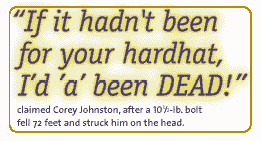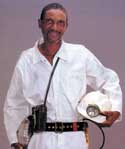
 Personal
protection for daily and emergency use are never more crucial
than in underground mining. MSA equipment recently saved 18 miners
from near-certain death at a Mpumalanga gold mine when a fire
filled their mining cavern with smoke. After donning their MSA
30/100 self-contained self-rescuers (designed to provide air during
emergency air shortages), the miners escaped and returned to the
welcome light above. Personal
protection for daily and emergency use are never more crucial
than in underground mining. MSA equipment recently saved 18 miners
from near-certain death at a Mpumalanga gold mine when a fire
filled their mining cavern with smoke. After donning their MSA
30/100 self-contained self-rescuers (designed to provide air during
emergency air shortages), the miners escaped and returned to the
welcome light above.
Les was working on a pile-driving site when he was hit
on the head with a 65-lb.chunk of mud and concrete.Although his
hardhat was destroyed and he did receive 14 stitches to the scalp,
Les would probably have been killed if he had not been wearing
head protection.
 A
Pennsylvania fire & rescue crew surveyed an automobile accident
scene on an interstate highway, and picked up a victim who was
lying near the overturned car. En route to the hospital, he regained
consciousness and asked about his pregnant wife. A
Pennsylvania fire & rescue crew surveyed an automobile accident
scene on an interstate highway, and picked up a victim who was
lying near the overturned car. En route to the hospital, he regained
consciousness and asked about his pregnant wife.
Back at the accident scene, two rescuers grabbed their MSA Thermal
Imaging Cameras, searched a dark wooded area, and quickly found
her about 200 feet away. She had wandered away from the accident
scene, delirious with head trauma.
To the Owner of this company:
 I
just bought our [MSA Safety Works ®] safety glasses this past
Saturday, because I like your design and also the mirror blue
style, plus you added a free neck cord with the deal. Well, this
past Monday I was working on the job when I pulled a nail that
was attached to a very taut string line, when the nail shot straight
up towards my face. Thank God I had your safety glasses on, because
I would have lost my left eye. They might have a huge scratch
in them, but my eye was saved — thanks to our excellent design! I
just bought our [MSA Safety Works ®] safety glasses this past
Saturday, because I like your design and also the mirror blue
style, plus you added a free neck cord with the deal. Well, this
past Monday I was working on the job when I pulled a nail that
was attached to a very taut string line, when the nail shot straight
up towards my face. Thank God I had your safety glasses on, because
I would have lost my left eye. They might have a huge scratch
in them, but my eye was saved — thanks to our excellent design!
Bob Crosetti
Darryl was trying to bull-rig a motor control center module
that was positioned on concrete piers. A wire-rope choker that
connected a 10-ton come-along to one of the concrete piers broke
loose and freed the come-along. The come-along swung around the
pier and struck Darryl in the head. HisV-Gard® Helmet deflected
the force of the impact and undoubtedly saved him from serious
injury.
Rick was attempting to open a valve manually on a high-pressure
flash tank. The valve stem suddenly shot upwards and broke the
valve bonnet, as well as the operating cylinder. The valve assembly
and piping shook violently, and Rick was knocked off the pipe.
Rick hit his head when he landed on the ground, but thanks to
his V-Gard® Helmet, he avoided serious injury.
Eric, a ventilation installation supervisor, fell about
three meters onto the steel deck of an offshore accommodation
module bound for the Gulf of Mexico. Although he suffered some
fairly serious injuries - fractured sternum, neck injury, and
a few stitches to the back of the head - he credited his MSA V-Gard
II hardhat (made in the United Kingdom) for staying in position
during the fall and withstanding the initial impact with the deck,
and "saving his neck." Important Note: Our V-Gard Cap is designed
to protect wearers from the impact of falling objects, and is
not meant to provide fall protection for the head.
Steve was operating equipment in an underground mine shaft
when a large piece of rock fell from the ceil- ing of the tunnel.Debris
rained down on Steve,and he was knocked to the tunnel floor.While
he did receive minor injuries,Steve ’s Topgard ®Full-Brim Cap
protected him from serious head injuries.
Neil was driving his scooptram through an underground passageway
when he struck his head on a low back area. The forehead section
of his hard-hat suspension was split instantly from the impact.
While Neil did suffer whiplash, his Topgard® Hat saved him from
serious injury or death.
According to the New York Daily News, FDNY officials credited
an MSA TIC with helping to save lives after a fire on Manhattan's
East Side consumed a two-bedroom apartment on the 24th floor,
then spread to the floor above.
The first wave of firefighters rode up to the blaze in an elevator.
Confronted with black smoke and hot spots of more than 1,000 degrees,
they used MSA's Evolution® 4000 TIC to spot a ceiling of flame
above them.
Firefighters in smoke-filled hallways used their TIC (which they
had just received the day before) to direct water toward flames
they couldn't see. Although 30 firefighters and residents were
injured, no one was seriously hurt.
Robert, a fire captain in Columbia, S.C., was wearing his
MSA Air Mask when he climbed the stairs in a burning two-story
apartment. Suddenly, the roof collapsed and swallowed him. He
was knocked to the floor and exposed to dense smoke and heat estimated
at 2,500 degrees F. As he struggled to free himself and exit the
building, his MSA Air Mask stayed in place, providing the fresh
air needed to keep him alive. Robert and his equipment were ablaze
as he escaped the hellish inferno, but he would live to fight
another fire.
While positioning nylon chokers to lift and remove a reactor
feed pump, a control link arm pivoted unexpectedly. The arm —
weighing more than 200 lbs.— glanced off Jeffrey’s V-Gard® Helmet
and knocked his safety glasses to the ground. While he received
a small laceration above his right eye brow, his hat had prevented
a direct hit and serious injury.
Gerald was working in Duke’s gas processing facility when
he was struck in the head by a 1 ” pipe. The pipe, driven by 800
lbs. of pressure, broke the suspension of his MSA hardhat upon
impact. The hat was then propelled more than 50 feet away from
the site of the accident. But Gerald himself suffered only a slight
concussion. Without the hard-hat, he surely would have received
a life-threatening head injury.
|
|
|

In below-zero temperatures,
a small construction crew poured a cement floor of 50,000
square feet inside a building that was enclosed in plastic,
to keep wind and snow out and the heat in. The heat came
from propane-fired heaters and kerosene-type jet heaters
with blowers.
Concrete trucks drove into the work area, with 10 to 12
trucks idling inside the building, as they waited to pour
their concrete. As one truck was emptied, another truck
arrived with more concrete, a common practice in a concrete
floor project of this size.
One crew had encompassed the bay with plastic, unwittingly
creating a confined space where a lone worker started to
float the concrete. When his co-workers returned to the
"plastic room," they found their friend lying face down
in the concrete. Although rushed to the hospital, he now
suffers from loss of involuntary motor functions (such as
breathing), attributed to an increased level of CO and an
oxygen deficiency.
Like so many others, they had followed this practice before,
without incident-thinking gas detection equipment such as
MSA's Orion™ Monitor unnecessary, too expensive, and too
complicated to calibrate.
[Addendum]
After this story appeared in Spotlight on Safety, an MSA
distributor representative in Indiana wrote that her husband,
an electrician, had encountered a similar incident on the
job. When his men began to show symptoms of CO exposure,
Roger instantly had them evacuate the building. Despite
a reprimand from the job foreman (for slowing down production),
Roger knows he did the right thing. His only regret is that
he did not have his Passport® Alarm with him that day.
|
|